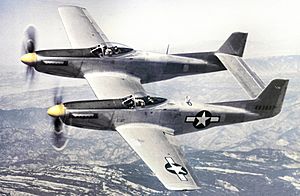Heavy fighter facts for kids

A heavy fighter was a type of fighter aircraft made in the 1930s and 1940s. These planes were designed to carry more powerful weapons. They could also fly for longer distances than smaller, "light fighter" planes. To do this, most heavy fighters had two engines. Many also had more than one crew member. This was different from light fighters, which usually had one engine and one pilot. In Germany, these planes were called Zerstörer, which means "destroyer."
Heavy fighters were an important type of aircraft before World War II. They were meant to fly long distances to protect bombers, or to shoot down enemy bombers. However, most of these designs did not work well for these jobs. They could not turn as quickly as smaller, single-engine fighters. Because of this, they often suffered heavy losses. A famous example is the Messerschmitt Bf 110, which lost many planes during the Battle of Britain.
One plane that did work well was the American Lockheed P-38 Lightning. It was a very good heavy fighter. It could even fight smaller, lighter, single-engine planes, especially in the Pacific Ocean area during the war.
Many twin-engine heavy fighters found new uses. They became night fighters, especially for destroying bombers in the dark. They also became fighter-bombers, which are similar to today's strike fighters. The Bf 110, for example, became a successful night fighter, ground attacker, and fighter-bomber for most of the war. The Bristol Beaufighter became a main anti-shipping strike fighter for the Royal Air Force. Some heavy fighters did succeed in their original roles. The de Havilland Mosquito was developed as a light bomber, fighter, and photo-reconnaissance plane. It was excellent as a fast light bomber, just as planned.
Almost every country fighting in World War II used or tried out twin-engine multi-role combat aircraft. These planes were not always called "heavy fighters" at the time.
Heavy Fighters After World War II
After World War II, some piston-engine heavy fighters continued to be used. These included the de Havilland Hornet and Sea Hornet, and the North American F-82 Twin Mustang. These planes were developed at the end of World War II for use in the Pacific. However, they did not reach active squadrons until after VJ Day (Victory over Japan Day). The Hornet started service in 1946, the Sea Hornet in 1947, and the Twin Mustang in 1948.

Today, modern 4th-generation and 5th-generation air superiority fighters are designed to control the skies over enemy territory. They usually have a longer range than smaller tactical fighters or interceptors. Because of this, they often have two engines. They can also carry more air-to-air missiles than smaller planes. These modern fighters also have more advanced radar and electronic systems. In older air-superiority fighters, like the McDonnell Douglas F-4 Phantom II or Grumman F-14 Tomcat, a second crew member was needed to manage the radar and weapon systems.
Images for kids
-
A Messerschmitt Bf 110 in flight
See also
 In Spanish: Caza pesado para niños
In Spanish: Caza pesado para niños






